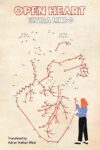[Other Press; 2011]
Tr. from German by Michael Hoffman
by Alena Jones
By taking up the familiar subject of spousal infidelity—here, successful and attractive Alex has a mistress on the side from his successful and attractive wife, Sonia—Peter Stamm’s Seven Years risks merely rehashing well-recorded problems of a 40-year-old man. Fortunately, though, by weaving into the story a rich but reserved examination of architectural themes and by emphasizing the ambiguity of Alex’s choices, Stamm avoids this danger. He instead crafts an engaging story that opens up beyond romantic complications and addresses possible structures and forms a life could take.
Set in the present but consisting mostly of Alex’s narration of the past, the story starts as he and Sonia welcome an old artist friend, Antje, to their town for her gallery show. Antje prods Alex to tell her about his other woman, a foreigner, whom she had always vaguely known about. He obliges and skips back to his first encounter with Ivona, a Polish woman. She is frumpy and timid, and, for Alex, remarkable only in her unattractiveness, yet he finds himself inexplicably drawn to her. He ends this first night at her apartment drunk and pawing at her, while she remains taciturn and resolutely nonsexual. Alex is drawn back to her several times over, and his dual feelings of repulsion and captivation only increase.
Meanwhile, he is just finishing up his architecture degree, and his friendship with Sonia, a fellow student, grows into a relationship. Alex is aware that by all external criteria his life seems perfect, but he is uneasy in his quick engagement to Sonia and returns again and again to dull, graceless Ivona.
The story from here does not follow the course of a man’s attempt to conquer his lust, salvage his marriage, or even scheme how to keep both women in his life. Rather, it follows Alex’s struggle to uncover the source of his attraction to Ivona and to examine, however indirectly or aloofly, what his life with Sonia lacks.
Stamm makes skilled use of his protagonist’s profession as architect to develop and illuminate the conflicts Alex faces. After aligning the process of constructing a building with living a life—a connection fittingly established when Alex and Sonia talk about Le Corbusier’s “machines for living” and the importance of interior, light, shade, and balance in such structures—Stamm allows us to use the frequent notes on architecture to help unpack Alex’s personal battles.
In this light, Alex’s realization, while he prepares to defend his thesis, that his student work is “completely unoriginal and unthought-out as to its interior” hints at his notions of an ideal life as well as an ideal architecture. His buildings were exteriors only, shaped by height and lot restrictions and lacking any sense of the lives to be lived inside. As the defense approaches, and just days after meeting Ivona, he declares he will pursue an architecture “that would allow feeling, that would enable [a] sort of freedom and openness.”
As Alex’s relationship with passionless and straight-laced Sonia grows, it becomes more and more apparent that Sonia’s life, and the life she offers Alex as a wife, resembles his abandoned style of building and, in fact, prohibits the organic movement and growth he proclaims he wants from his structures. His intention to escape such a restrictive architecture is now coupled with his wish to cultivate active, genuine emotional and creative drives in his life.
Stamm is careful never to align Ivona with Alex’s ideal architecture, despite her differences from Sonia, and this avoidance of such an easy route is a fine accomplishment for the author. Like Alex himself, we remain uncertain about why he is attracted to Ivona and even more doubtful about whether a relationship with her could result in the open, integrated structure he has conceived of.
Several times when Alex is in Ivona’s company, an Aldo Rossi maxim, “Every room contains an abyss,” crosses his mind; as Alex savors the stillness and seclusion he experiences with her, we realize that Stamm is doing an excellent job keeping him floating, directionless and ambitionless, in this very abyss. He never moves forward, or anywhere really, with Ivona. He confines himself intentionally to single, sluggish afternoons indoors with her. All the while, he remains unsatisfied with the emotionless, auto-piloted life he lives with Sonia. As readers, we continue to be uncertain about which path or theory would lead Alex to his goal.
The dexterity with which the author pulls off this balance allows us to overlook a few of the weaker moments in the text. Stamm fumbles the architecture metaphor only a couple of times, adding in perhaps a few too many scenes featuring small models of houses whose figurine inhabitants have slipped off their bases or in which friends build furniture together and talk about life. And alongside Alex’s complex character, one of Sonia’s suitors is so caricatured, lecturing fellow partygoers about udders and dirndls, that he seems to have been plucked from a Preston Sturges film, briefly throwing off the tone of the text.
Overall, though, Seven Years is an absorbing story that effectively expands one man’s problems into a broader context. Stamm demonstrates finesse throughout the novel, both in shaping a subtle and believable narrator and in employing architectural themes to probe at Alex’s personal conflicts. In considering what our buildings should provide us and what roles we might play in their construction, the book proves itself relevant to draftsmen, spouses, and any other readers who want more than just a roof over their heads.
This post may contain affiliate links.








